I had not returned to the city since the pandemic and went to attend the Memorial for writer and Pulitzer Prize winner, Ted Morgan who died last December. It took place at the Century association and was mostly a family affair, with his daughter Amber de Gramont (who recently retrieved her family name) and his son Gabriel Morgan, both speaking in a very sensitive and literary way of him as a father. His wife Eileen Bresnahan read a beautiful poem and his grandchildren and nephews, the artist George and his twin, film director Michel Negroponte, added to the glamour. Another niece, the author Nina de Gramont was there with her husband, David Gessner, also a writer, and Clement Wood son of the Paris Review International editor, brought some of the literary French past with him. The cultural event of the week was “the Harlem Renaissance” exhibition at the Metropolitan museum which I saw just after learning of Faith Ringgold‘s death at 93. The extraordinary artist, who was exhibited at Musée Picasso exactly a year ago, was born in Harlem in 1930, just at the time of the Renaissance… The show is a mix of fabulous portraits by Winold Reiss, Laura Wheeler Waring, Archibald J. Motley. Jr and Jacob Lawrence or William H. Johnson. But there were also very mediocre ones mixed among the excellent photos by James Van Der Zee. I would call the exhibition unedited or wanting to show too much?
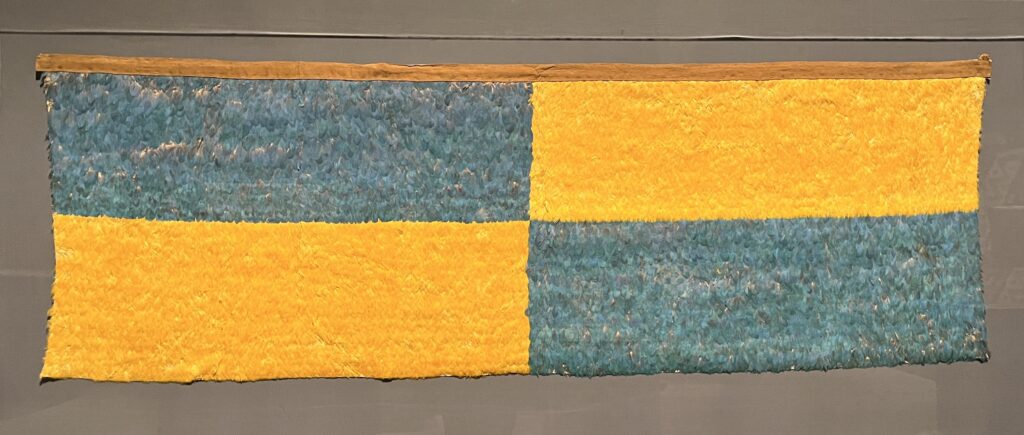
Wari artist, Churunga Valle, Peru, Feathered panel 600-900, The Metropolitan Museum of Art, The Michael C. Rockefeller Memorial Collection
I was very impressed by how Latino New York has become with the visit of the (uninteresting) Whitney Biennial where all the cartels were in English and in Spanish and two very wonderful exhibitions. One on Peruvian weaving at the Metropolitan museum, a big touristic bazaar, which becomes very calm in the European galleries, where unfortunately, a “trendy” curator has decided to hang Francis Bacon next to the Master of the Orcagnesque Misericordia, Elaine de Kooning next to the ravishing Marie-Victoire Lemoine and Max Beckman next to Jean Bellegambe‘s 16 th century altarpiece. Does he think that these wonderful modern paintings will wake up the public’s eye? Both are really wasted. It reminded me of the David Hockney painting in Rouen recently which made two Monet landscapes look pale…
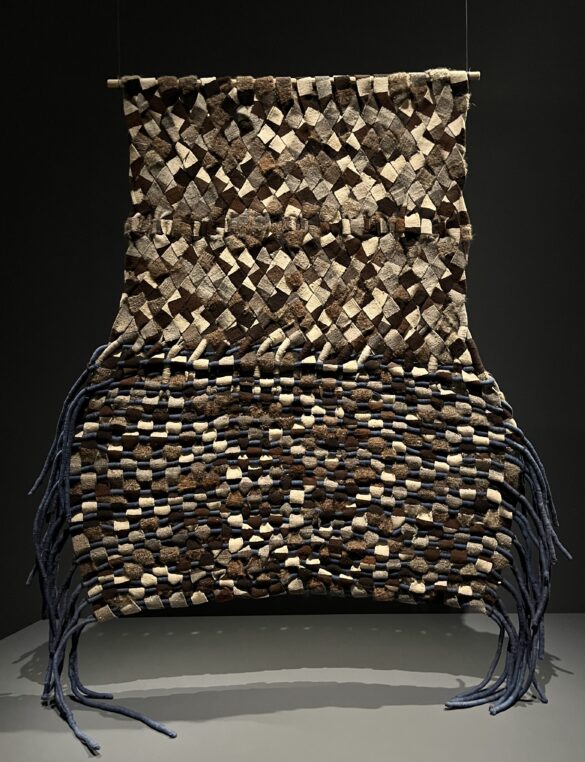
Olga de Amaral, “Muro tejido cuadriculado” (Woven gridded wall #66), 1970, Museum of Arts and Design New York
But there was a little jewel, “Weaving Abstraction in Ancient and Modern Art” (until June 16) devoted to Peruvian artists from the 600 to 1600, and contemporary weavers inspired by them such as Anni Albers, Sheila Hicks, Lenore Tawney and Olga de Amaral. It is virtually impossible to find because the fifty works are hidden in the further contemporary rooms n°913 of the Met, but with a little perseverance, art historian Cynthia Saltzman and I found it. And loved it. “Each of the four modern artists featured developed innovative approaches to an ancient medium through deep study of Andean traditions” and to show them together was a major coup. A catalog can be read online. I am a fan of Sheila Hicks who lives in Paris but discovered the two latter artists who are very strong and was fascinated to learn that the feathered panel from 600-900 had been perfectly preserved, rolled up in ceramic vessels buried at a site of ritual importance on Peru’s South Coast!

Chuquibamba artist, South Coast Peru, “Bag with fringe”, 12 th-16 th century camelid fiber, The Metropolitan Museum of Art
The quiet and concentration of visitors in these galleries is a wonderful contrast to the agitation throughout the museum and the shop and it was a great moment of happiness to see, ate the retrospective at MAM Paris, Anni Albers’ tapestries again as well as her disciples’. The show which puts forward the importance of textiles in the exchanges in the pre hispanic period in the Andes, is curated by Iria Candela and Joanne Pillsbury.
From there I took the cross town bus to get the subway to 157 th street where I wanted to visit the Hispanic Society of America, built in 1904 by Archer M. Huntington. It is the most extraordinary building in Washington Heights with a collection of Velazquez, Goya and El Greco and a stunning room decorated by Joaquin Sorolla with all the Spanish provinces and their customs. The institution is run by the brilliant French curator, Guillaume Kientz, formerly at the Kimball and at the Louvre. But sadly, the second floor is closed because non accessible to handicapped visitors and I contented myself with three absolute masterworks on the ground floor.
It was my first visit to this amazing place and watching the buildings around the museum led me to dream about life in the 1900’s in New York, before Harlem became what it is now. I had lunch at Chelas, a Peruvian restaurant across the street, where I had a Ceviche of course and fried chicken. The atmosphere is very special with street vendors and tropical fruit and vegetable all around. A special exhibition by Cuban born American artist Enrique Martinez Celaya had opened the day before in the atrium and the decor on the ceiling and in the show windows featured paper boats made in the school where the artist had studied as a young boy. His large paintings of the sea and of boats are reminiscent of his childhood in Cuba which he left in 1971, at age 7, to join his father in Madrid.
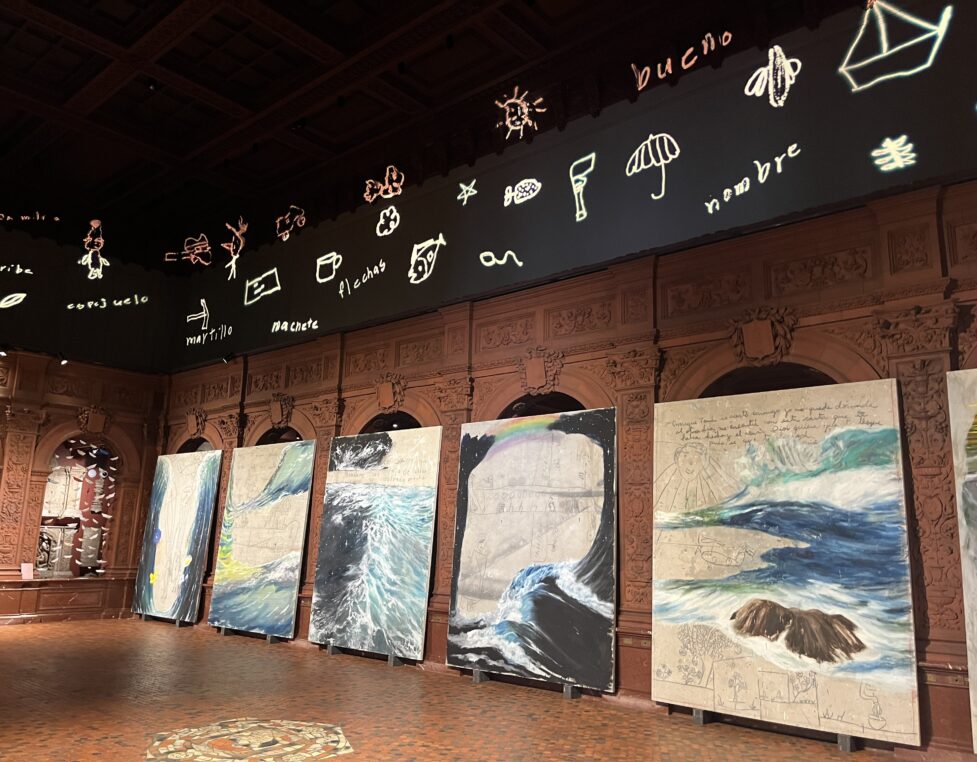
Enrique Martinez Celaya, “The World Shimmering Sea”, is a dialogue with Velazquez, and other works from the Hispanic Society collection, 2024
His works are very powerful in the big hall and lead the way to the Joaquin Sorolla room, a fabulous series of fourteen paintings of life in provincial Spain painted from 1911 to 1919. The Spanish painter had exhibited in New York for the first time at the Hispanic Society in 1909 and this commission by Archer Huntington made the museum famous. With the Duchess of Alba by Goya, and portrait of a Little girl by Velazquez, and the Greco of course, the visit of this unique institution was full of surprises. I even encountered cuban painter Emilio Sanchez‘s spiral bound calendar of drawings which are shown along an amazing Filippino ivory sculpture of St Joseph and Christ.
There were more exhibitions like Sonia Delaunay at the exquisite Bard’s graduate center on 18 West 86 street (until July 7) and five Gustav Klimt paintings of his garden at the Neue Gallery, which is a s elegant as ever. So much to see and so little time.
I had long conversations with National Book award laureate Lilian Tuck, who is publishing in December at Liveright, an imprint of Norton, with editor Bob Weil, a novel based on Czeslawa Kwoka, a 14 year old Polish girl, who was one of the 45 000 catholics to die in 1942-1943 in Auschwitz.
On the flight back I read “Knife“, Salman Rushdie’s very immediate account of his stabbing in Chautauqua, N.Y., on August 12, 2022, and his two years of survival. I highly recommend the read which is full of personal family feelings and a tribute to his wife, Rachel Eliza Griffiths, a poet, translator and film director. He writes about his sufferings since in a very modest way and his writing is very accessible.

Salman Rushdie’s latest book “Knife” was published simultaneously around the world, last week, by Random House
Share this Post
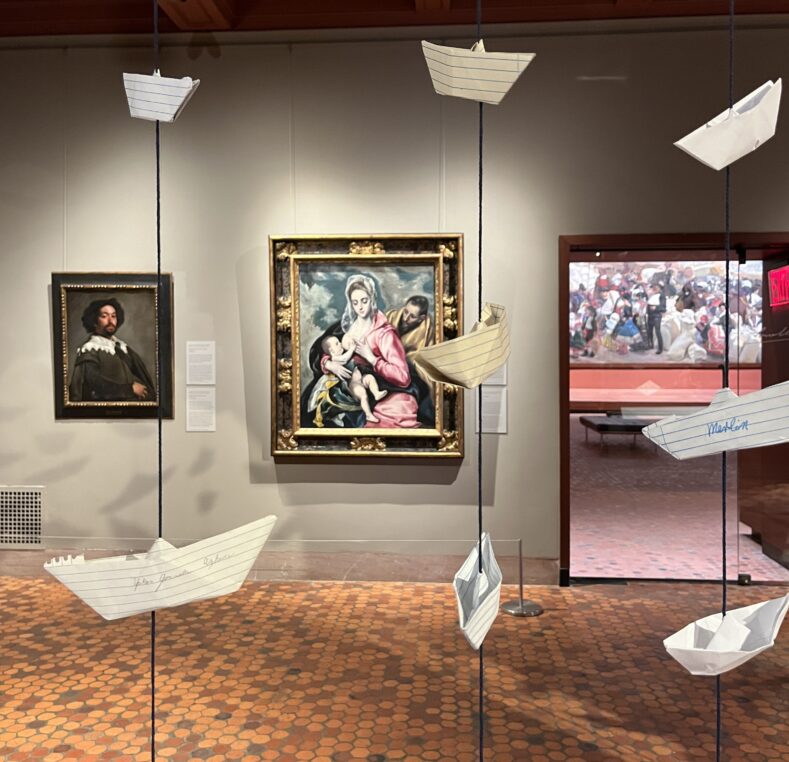
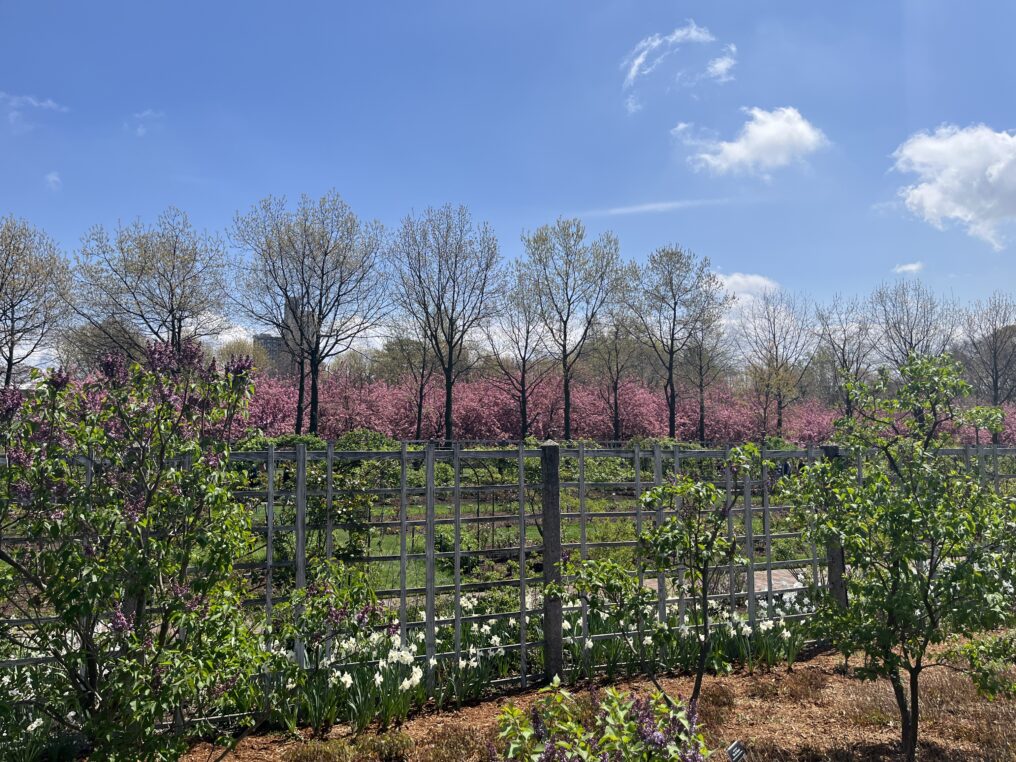
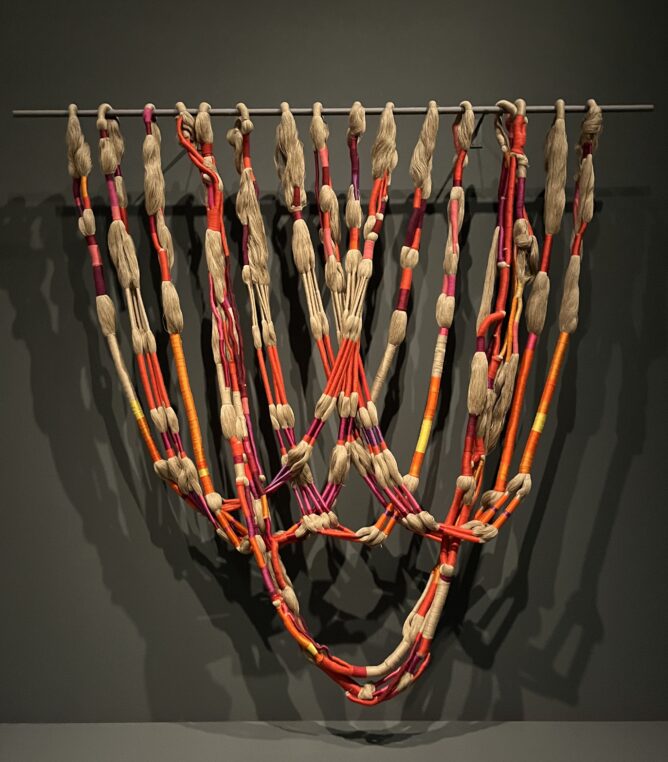
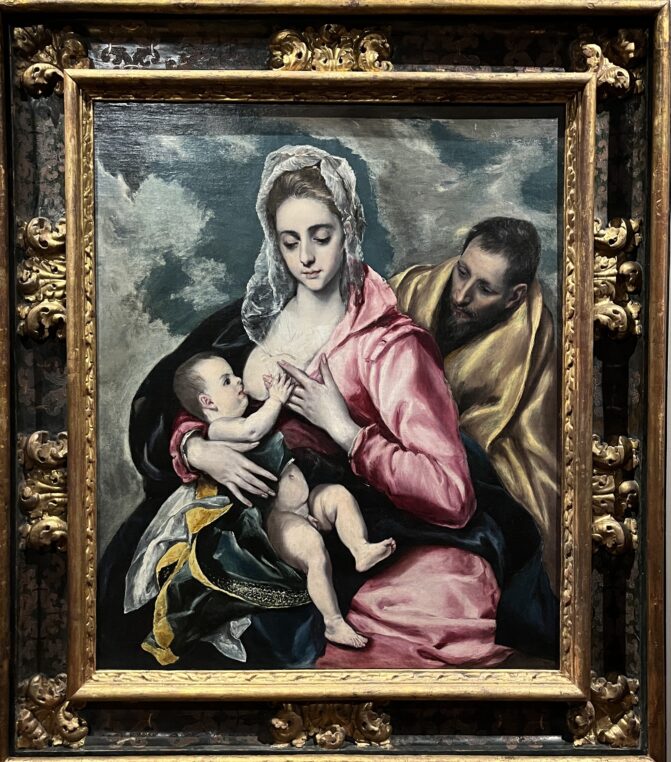

7 Comments on “Back to New York after six years and full of new discoveries”
Merci chère Laure , je lis tes bons plans assise dans la salle d’embarquement pour le vol de NY.
Thank you for this interesting report of your visit to New York. I am sad to learn that Ted Morgan died. When I lived in New York in the 1970’s I had the pleasure to make his acquaintance through a mutual friend, Anne Freemantle, who periodically held a literary salon that attracted many interesting literary figures, Ted amongst them. It was a world that, as a young man still in my twenties, I found inspiring as well as dazzling. Anne’s autobiography, The Three-Cornered Heart, is a most wonderful book which, if you can find a copy, you would enjoy reading. In many ways Anne Freemantle was very much like Anne de Fayet, a very dear friend who died last year. They brought friends together. Through Anne Freemantle I met Ted Morgan. Through Anne de Fayet your Paris Letter came to my attention. For both gestures I am grateful.
I am delighted to learn there was a memorial service for Ted Morgan. So well deserved. I loved reading his book The French many years ago and should reread it today.
Your report on the Hispanic Society was fascinating. As an ex- New Yorker, I was very taken with your description.
Sonia just blocks away! ?
Thank you for your excellent NYC edit
As usual when you come to New York, Laure, you see more in a few days than those of us who live here see in a year! And you make discoveries for us. I’m so glad you noted the small textile show at the Met —a revelation it one can find the gallery tucked far away.
Cathleen
Merci, Laure, pour les cerisiers en fleur à Brooklyn et pour le magnifique Greco !
Deux merveilles…
New York? Paris? When I arrive in one, I yearn for the other. After a bit of housekeeping I’ll be on the road again. Thanks for all you share with us.